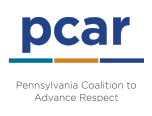In an effort to expand and enhance services to survivors with disabilities and Deaf and Hard of Hearing survivors, PCAR and IDJ have created a virtual learning resource to assist sexual assault programs, advocates, and other service providers in building capacity to work with people with disabilities. This curriculum is a self-paced, free learning opportunity for anyone interested in disability justice and violence prevention.
Table of Contents
Disability Justice, Violence Prevention, and Abolitionism Curriculum Introduction
- Purpose
- Defining the Project
- Cognitive Accessibility of Curriculum Language: Plain Language
- Defining Disability
- White Supremacy, Capitalism, Intersectionality, and Disability Justice
- Notes on Language Choices
- Values
- Curriculum Outline
Section 1: Introduction to Disability Justice, Practicing Respect, and Identities
- Area 1: Disability Identities and Violence against People with Disabilities
- Area 2: Models of Disability and Disability Justice as an Applied Framework
- Area 3: Working More Effectively with Disabled Colleagues and Clients through Disability Justice
Section 2: Psychiatric and Traumagenic Disabilities
- Area 1: Psychiatric and Traumagenic Disability Experiences
- Area 2: Supporting Survivors with Psychiatric & Traumagenic Disabilities
- Area 3: Connecting Psychiatry and Abolition
Section 3: Cognitive and Developmental Disabilities
- Area 1: Decision Making and Dignity of Risk
- Area 2: Safer Sex and Affirming Sexuality
- Area 3: Collaboration and Advocacy
Section 4: Physical Disabilities
- Area 1: Disability Visibility and Accessibility Basics
- Area 2: Services & Collaboration with People with Physical Disabilities
- Area 1: Blindness 101 – How to Interact with Blind People
- Area 2: Creating Accessible Spaces and Materials
- Area 3: Resources for Blind Survivors
Section 6: Deaf and Hard of Hearing Communities
- Area 1: Audism and Language Deprivation
- Area 2: Language Justice & Disability Justice
- Area 3: Deaf Survivors and Deaf Experiences
- Area 4: Addressing Barriers for Deaf Survivors
Section 7: Chronic Illness, Chronic Pain, Fatphobia, and Capitalist Profiteering
- Area 1: Lived Experiences of Chronically Ill People & Basic Allyship
- Area 2: Capitalism and the Medical Industrial Complex
- Area 3: Fat Liberation and Disability
Section 8: Disability Justice, Policy, and Institutional Change
- Area 1: Organizational Policies & Capacity Building
- Area 2: Abolition, Violence Prevention, and Organizations
- Area 3: Financing for Violence Prevention & Accessibility
- Area 4: Organizational Culture
Section 9: Ableism, Violence, and Violence Prevention
- Area 1: Lived Experiences of Ableism
- Area 2: Historic Examples of Ableism
- Area 3: Types and Forms of Ableism
- Area 4: Ableism and Sexual and Intimate Partner Violence
- Area 5: Ableism and Violence Prevention
Appendix: Additional Resources
- Disability History
- Disability Justice and Abolition
- Disability Justice and Intersectionality
